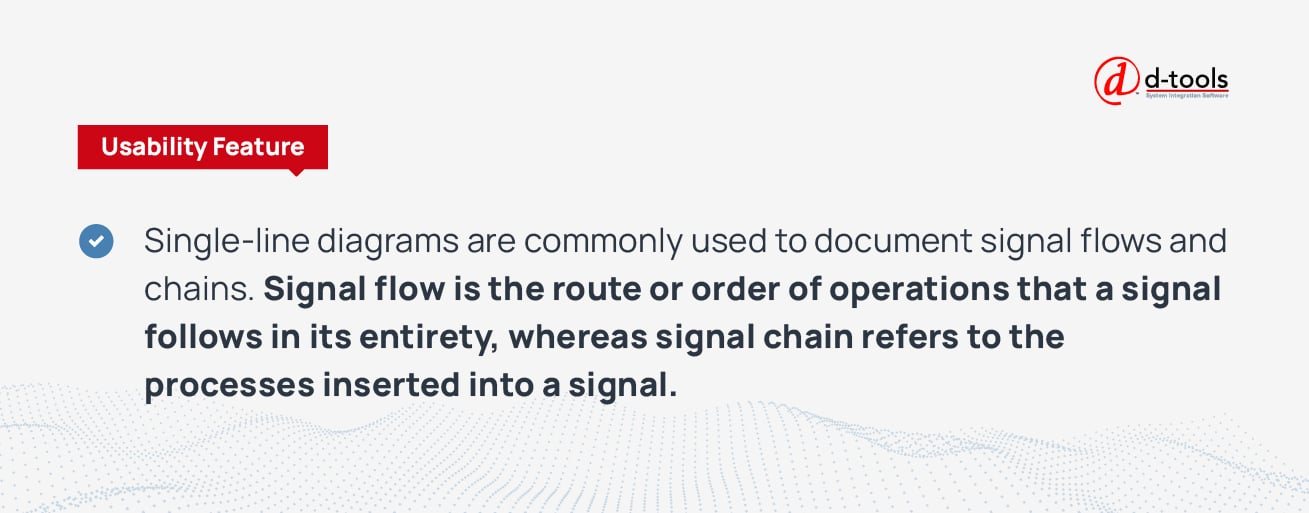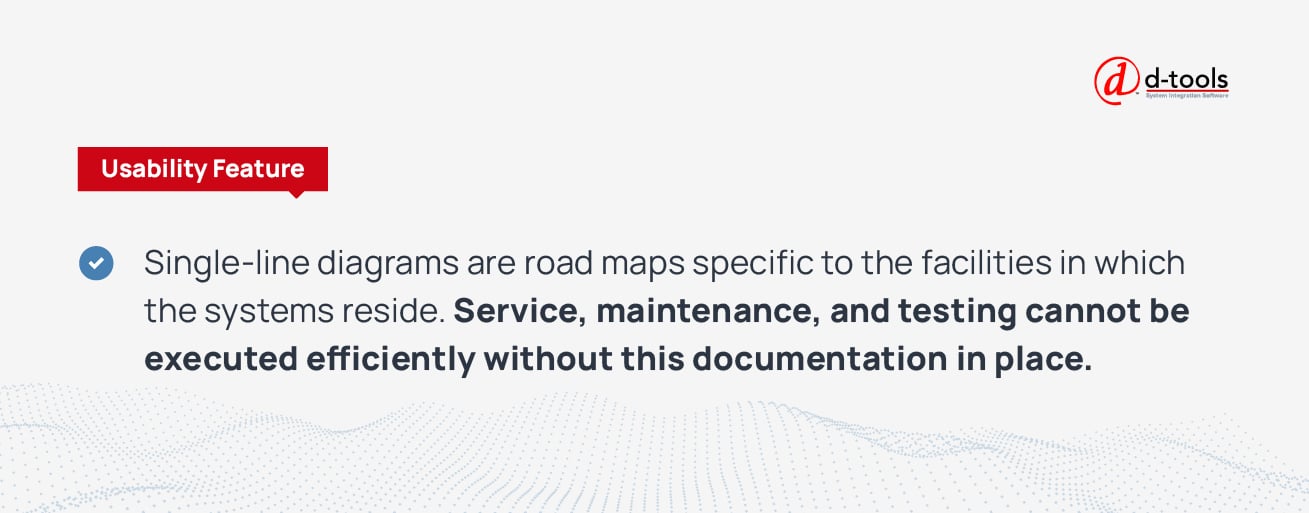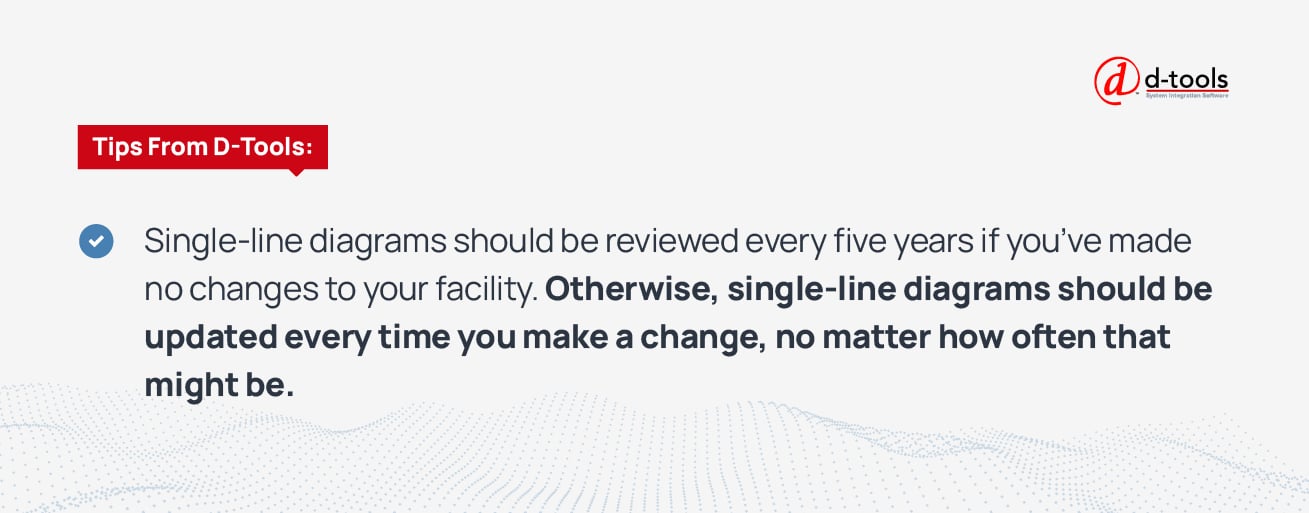For AV system design projects, single-line diagrams (SLDs) are often used to depict the flow of audio, video, control, and data signals. These diagrams help show the overall intent of the system as well as make the signal path more understandable. It’s the latter that makes single-line diagrams not just important but essential for AV installations.
In this article, we will define single-line diagrams, outline the basic process for creating them, explain their importance, and provide an overview of how to make a single-line diagram in AutoCAD.

What Is a Single-Line Diagram?
A single-line diagram, also known as a one-line diagram, typically provides a simplified representation of how incoming power is distributed to equipment. However, in the AV industry, single-line diagrams are commonly used to document signal flows and chains. Signal flow is the route or order of operations that a signal follows in its entirety, whereas signal chain refers to the processes inserted into a signal.
Signal flows and chains can be complicated, but single-line diagrams help condense them into simple drawings to show the correct paths from incoming signals to each AV system component. These high-level schematic diagrams use single lines and graphic symbols for ease of use and readability. They map signals and track each component, so technicians can properly install and maintain complex AV systems.
Although a single-line drawing is simple, it is still granular enough to show how the components of the system are connected, include the sizes and ratings of each piece of equipment, and denote protective devices and circuit conductors. Still, single-line diagrams are considered one of the most basic blueprints for AV installations.
Basic Process to Create a Single-Line Diagram
The process of creating a single-line diagram usually looks like this:
- A system designer outlines each of the devices and components that will be installed in the system.
- To estimate fault-current calculations, wire paths, equipment evaluation, and selective coordination needs, the designer creates assumptions.
- Technicians and installers mark up the single-line diagram as they work, making changes and adjustments as needed.
- The single-line diagram is then updated to reflect the actual installation.
Although single-line diagrams are best-known for their use in electrical engineering, these drawings are often used to depict AV systems. Again, these single-line diagrams are flow charts showing the signal flow in an AV project to provide a conceptual overview. It’s easy to see why such drawings are useful for planning a complicated AV system before it is installed, and for ensuring that everyone working on the project has a visual map of the system to work from.
What Is the Importance of Single-Line Diagrams?
It’s common for single-line diagrams to get attention when a system is new, but as time passes, they can become obsolete if they’re not updated as they should be. No matter the age of a system, having a single-line diagram is critical. They are needed for maintenance as well as for troubleshooting daily operations. If a signal is routed incorrectly or cut short at any point, it won’t make it to the last step in the chain.

The importance of single-line diagrams lies in the fact that they are road maps specific to the systems’ facilities. Service, maintenance, and testing cannot be executed efficiently without this documentation in place. Your systems will not be protected unless you have a current single-line diagram that accurately depicts your facility as it is today; without it, you cannot fully understand the layout and design.
5 Benefits of Single-Line Diagrams
Now that we’ve established the importance of single-line diagrams, here are some specific benefits of having an up-to-date single-line diagram of your AV or electrical system:
Benefit 1
A single-line diagram helps you know when you need to perform troubleshooting. It also simplifies the troubleshooting process because you’ll have current information to work from.
Benefit 2
Single-line diagrams are important for preventing electrical accidents. Your facility is safer for employees when your electrical single-line diagram is kept up to date by reflecting the current power system setup.
Benefit 3
To comply with local, state, and federal regulations and standards, a single-line diagram is often needed.
Benefit 4
A system is far more dependable when it is well-documented. An accurate diagram ensures optimum system performance and coordination for all future testing.
Benefit 5
A single-line diagram is essential when preparing a critical response plan. It can become a facility’s lifeline of information when updating or responding to an emergency.
Unfortunately, key decision-makers may disregard the need for single-line diagrams, not understanding why they should be kept up to date. In fact, it’s common for facilities to operate with single-line diagrams that are out of date and no longer reflect current systems. It’s not until these systems fail that the importance of single-line diagrams is realized.
When Should Single-Line Diagrams Be Updated?
Because electricians, engineers, designers, installers, and technicians all rely upon single-line diagrams, it’s important to have an up-to-date diagram available at all times. But what does up to date really mean?

Experts recommend that single-line diagrams be reviewed every five years if you’ve made no changes to your facility. Otherwise, single-line diagrams should be updated every time you make a change, no matter how often that might be. Some examples of changes that would call for a new single-line diagram include:
- A new installation in the facility
- A modification to the existing system
- Change in utility or source
- Change in system impedance, configuration, or loading
- Change in protection devices or settings
Keeping a single-line diagram current is a little bit like going to the doctor for annual physicals or taking your car to the shop for routine maintenance. It might be a hassle and cost a bit of money, but you’ll be avoiding even bigger hassles and expenses by staying on top of things.
To ensure that single-line diagram updates are always accounted for in a facility’s budget, companies may want to consider creating budget line items for them. Having the resources set aside for regular updates makes the process easier; it also facilitates a conversation with stakeholders about why single-line diagrams must be kept up to date at all times.
How to Create a Single-Line Diagram in AutoCAD
Although a single-line diagram can certainly be drawn by hand, AutoCAD is one of many tools that are well-suited to creating single-line diagrams. First, you’ll need to know how to draw a line with measurements in AutoCAD:
- From the Home tab, go to the Draw panel, then Line.
- Click in the drawing area where you’d like the line segment to start and end.
- Press Enter or Esc when you’re done.
- Click on Measure and choose Distance.
- Specify a first and second point; use object snaps for precision.
There are specialized AutoCAD blocks with the symbols that are needed for single-line diagrams; you can either find these via a web search, or create your own and save them for future use.
A single-line diagram of a facility’s audiovisual system should include the following information:
- A detailed legend
- Identification of equipment
- Incoming service voltage
- Transformer ratings
- Voltage ratio
- Impedance
- Winding connections
- Feeder cable phase, neutral, and ground sizes
- Conductor material and conduit size and type
- Switchgear, switchboards, MCCs, fuses, panelboards, circuit breakers, automatic transfer switches, and continuous current ratings
- Protective relays with device numbers, and CTs with associated ratios
- Equipment rated current
- Bus voltage, frequency, phases, and short circuit current withstand ratings
- Cable number, lengths, and sizes
- Transformer connection type, voltages, kVA, and impedance
- Generator voltage and kW
- Motor HP
- Current and voltage ratios of instrument transformers
- Relay device numbers
If you use D-Tools System Integration (SI) Software for AV system design, you can create an AutoCAD line drawing using the integrated AutoCAD interface. SI also has a resource library of AutoCAD blocks containing vital engineering and product information to be used in line with drawings. Creating your single-line diagram in SI allows for seamless integration with the rest of your workflow, from proposals through field service management, letting others in your company access the diagram whenever needed, whether for installation or updates.
The Bottom Line on SLDs
While it’s common to lose sight of the importance of single-line diagrams when there are more pressing concerns regarding day-to-day operations, facilities must set aside the time and budget to keep these diagrams up to date. By doing so, disruptions in operations can be avoided; even more importantly, facilities are safer when there is robust documentation of electrical systems at the ready.

Get Started with D-Tools
The integrated AutoCAD and Visio interfaces in D-Tools SI streamline a data-driven process of creating and updating single-line diagrams for AV systems. Learn more about these engineering drawing software integrations.



